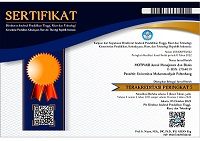PERAN KEPERCAYAAN PADA PEMASARAN INFLUENSER UNTUK MENINGKATKAN LOYALITAS MEREK
Abstract
Purpose– This research aims to examine the direct and indirect roles of the relationship between the credibility and attractiveness of influencers on brand loyalty among young consumers in Indonesia, mediated by trust.
Design/methodology– This research employs a quantitative explanatory approach with a non-experimental cross-sectional method aimed at examining the relationships between the proposed variables. The survey was conducted online using Google Forms, and respondents were selected using a non-random purposive sampling technique. The analytical tool utilized was SmartPLS version 3.2.9
Findings - The research results indicate that the factor of source credibility has no direct effect on brand loyalty. In contrast, attractiveness exhibits a significant positive relationship with brand loyalty. Additionally, influencer credibility and attractiveness are found to have a significant positive relationship with trust. Finally, trust demonstrates a significant positive relationship with brand loyalty. This research is expected to contribute to the existing literature on the role of influencers in marketing communication activities, particularly in terms of brand loyalty, for both academics and practitioners.
Keywords
Full Text:
PDFReferences
Agnihotri, A., & Bhattacharya, S. (2021). Endorsement Effectiveness of Celebrities versus Social Media Influencers in the Materialistic Cultural Environment of India. Journal of International Consumer Marketing, 33(3), 280–302. https://doi.org/10.1080/08961530.2020.1786875
Altman, I., & Taylor, D. A. (1973). Social Penetration: The Development of Interpersonal Relationships. Holt, Rinehart, & Winston.
Amine, A. (1998). Consumers’ true brand loyalty: the central role of commitment. Journal of Strategic Marketing, 6(4), 305–319. https://doi.org/10.1080/096525498346577
Belanche, D., Casaló, L. V., Flavián, M., & Ibáñez-Sánchez, S. (2021). Building influencers’ credibility on Instagram: Effects on followers’ attitudes and behavioral responses toward the influencer. Journal of Retailing and Consumer Services, 61, 102585. https://doi.org/10.1016/j.jretconser.2021.102585
Bentler, P. M., & Bonett, D. G. (1980). Significance tests and goodness of fit in the analysis of covariance structures. Psychological Bulletin, 88(3), 588–606. https://doi.org/10.1037/0033-2909.88.3.588
Bhattacharya, A. (2022). Parasocial Interaction in Social Media Influencer-Based Marketing: An SEM Approach. Journal of Internet Commerce, 1–21. https://doi.org/10.1080/15332861.2022.2049112
Chin, W. W. (1998). The Partial Least Squares Approach to Structural Equation Modeling (In Marcoulides, G.A). Lawrence Erlbaum Associates Publishers.
De Veirman, M., Cauberghe, V., & Hudders, L. (2017). Marketing through Instagram influencers: the impact of number of followers and product divergence on brand attitude. International Journal of Advertising, 36(5), 798–828. https://doi.org/10.1080/02650487.2017.1348035
Fornell, C., & Larcker, D. F. (1981). Evaluating Structural Equation Models with Unobservable Variables and Measurement Error. Journal of Marketing Research, 18(1), 39. https://doi.org/10.2307/3151312
Ghozali, I. (2014). Structural Equation Modeling: Metode Alternatif dengan Partial Least Squares (PLS) (4th ed.). Badan Penerbit Universitas Diponegoro.
Ghozali, I., & Latan, H. (2015). Partial Least Squares: Konsep, Teknik, dan Aplikasi Menggunakan Program SmartPLS 3.0. Badan Penerbit Universitas Diponegoro.
Gilly, M. C., Graham, J. L., Wolfinbarger, M. F., & Yale, L. J. (1998). A Dyadic Study of Interpersonal Information Search. Journal of the Academy of Marketing Science, 26(2), 83–100. https://doi.org/10.1177/0092070398262001
Gong, W., & Li, X. (2017). Engaging fans on microblog: the synthetic influence of parasocial interaction and source characteristics on celebrity endorsement. Psychology & Marketing, 34(7), 720–732. https://doi.org/10.1002/mar.21018
Grisaffe, D. B., & Nguyen, H. P. (2011). Antecedents of emotional attachment to brands. Journal of Business Research, 64(10), 1052–1059. https://doi.org/10.1016/j.jbusres.2010.11.002
Horai, J., Naccari, N., & Fatoullah, E. (1974). The Effects of Expertise and Physical Attractiveness Upon Opinion Agreement and Liking. Sociometry, 37(4), 601. https://doi.org/10.2307/2786431
Hu, L., & Bentler, P. M. (1999). Cutoff Criteria for Fit Indexes in Covariance Structure Analysis: Conventional Criteria versus New Alternatives. Structural Equation Modeling: A Multidisciplinary Journal, 6(1), 1–55. https://doi.org/10.1080/10705519909540118
Hwang, K., & Zhang, Q. (2018). Influence of parasocial relationship between digital celebrities and their followers on followers’ purchase and electronic word-of-mouth intentions, and persuasion knowledge. Computers in Human Behavior, 87, 155–173. https://doi.org/10.1016/j.chb.2018.05.029
Janssen, L., Schouten, A. P., & Croes, E. A. J. (2022). Influencer advertising on Instagram: product-influencer fit and number of followers affect advertising outcomes and influencer evaluations via credibility and identification. International Journal of Advertising, 41(1), 101–127. https://doi.org/10.1080/02650487.2021.1994205
Jin, S. V., Jin, S. V., Muqaddam, A., & Ryu, E. (2019). Instafamous and social media influencer marketing. Marketing Intelligence & Planning. https://doi.org/10.1108/mip-09-2018-0375
Joseph, W. B. (1982). The Credibility of Physically Attractive Communicators: A Review. Journal of Advertising, 11(3), 15–24. https://doi.org/10.1080/00913367.1982.10672807
Kim, D. Y., & Kim, H. Y. (2021). Trust me, trust me not: A nuanced view of influencer marketing on social media. Journal of Business Research, 134, 223–232. https://doi.org/10.1016/j.jbusres.2021.05.024
Kim, J., Morris, J. D., & Swait, J. (2008). Antecedents of True Brand Loyalty. Journal of Advertising, 37(2), 99–117. https://doi.org/10.2753/JOA0091-3367370208
Kim, S., Choe, J. Y., & Petrick, J. F. (2018). The effect of celebrity on brand awareness, perceived quality, brand image, brand loyalty, and destination attachment to a literary festival. Journal of Destination Marketing & Management, 9, 320–329. https://doi.org/10.1016/j.jdmm.2018.03.006
Lee, J. E., & Watkins, B. (2016). YouTube vloggers’ influence on consumer luxury brand perceptions and intentions. Journal of Business Research, 69(12), 5753–5760. https://doi.org/10.1016/j.jbusres.2016.04.171
Lee, S., & Kim, E. (2020). Influencer marketing on Instagram: How sponsorship disclosure, influencer credibility, and brand credibility impact the effectiveness of Instagram promotional post. Journal of Global Fashion Marketing, 11(3), 232–249. https://doi.org/10.1080/20932685.2020.1752766
Leite, F. P., & Baptista, P. de P. (2022). The effects of social media influencers’ self-disclosure on behavioral intentions: The role of source credibility, parasocial relationships, and brand trust. Journal of Marketing Theory and Practice, 30(3), 295–311. https://doi.org/10.1080/10696679.2021.1935275
Liu, M. T., Liu, Y., & Zhang, L. L. (2019). Vlog and brand evaluations: the influence of parasocial interaction. Asia Pacific Journal of Marketing and Logistics, 31(2), 419–436. https://doi.org/10.1108/APJML-01-2018-0021
Lou, C., & Yuan, S. (2019). Influencer Marketing: How Message Value and Credibility Affect Consumer Trust of Branded Content on Social Media. Journal of Interactive Advertising, 19(1), 58–73. https://doi.org/10.1080/15252019.2018.1533501
Markplus Inc. (2022). WOW Brand Series: Influencer Marketing 2022.
McCracken, G. (1989). Who is the Celebrity Endorser? Cultural Foundations of the Endorsement Process. Journal of Consumer Research, 16(3), 310. https://doi.org/10.1086/209217
McGuire, I. E. (1968). The Origin of Newton’s Doctrine of Essential Qualities. Centaurus, 12(4), 233–260. https://doi.org/10.1111/j.1600-0498.1968.tb00096.x
Moorman, C., Deshpande, R., & Zaltman, G. (1993). Factors Affecting Trust in Market Research Relationships. Journal of Marketing, 57(1), 81. https://doi.org/10.2307/1252059
Morgan, R. M., & Hunt, S. D. (1994). The Commitment-Trust Theory of Relationship Marketing. Journal of Marketing, 58(3), 20–38. https://doi.org/10.1177/002224299405800302
Nam, J., Ekinci, Y., & Whyatt, G. (2011). Brand equity, brand loyalty and consumer satisfaction. Annals of Tourism Research, 38(3), 1009–1030. https://doi.org/10.1016/j.annals.2011.01.015
Ohanian, R. (1990). Construction and Validation of a Scale to Measure Celebrity Endorsers’ Perceived Expertise, Trustworthiness, and Attractiveness. Journal of Advertising, 19(3), 39–52. https://doi.org/10.1080/00913367.1990.10673191
Oliver, R. L. (1999). Whence Consumer Loyalty? Journal of Marketing, 63(4_suppl1), 33–44. https://doi.org/10.1177/00222429990634s105
Phua, J., Jin, S. V., & Kim, J. (Jay). (2017). Gratifications of using Facebook, Twitter, Instagram, or Snapchat to follow brands: The moderating effect of social comparison, trust, tie strength, and network homophily on brand identification, brand engagement, brand commitment, and membership intention. Telematics and Informatics, 34(1), 412–424. https://doi.org/10.1016/j.tele.2016.06.004
Saima, & Khan, M. A. (2021). Effect of Social Media Influencer Marketing on Consumers’ Purchase Intention and the Mediating Role of Credibility. Journal of Promotion Management, 27(4), 503–523. https://doi.org/10.1080/10496491.2020.1851847
Sakib, M. N., Zolfagharian, M., & Yazdanparast, A. (2020). Does parasocial interaction with weight loss vloggers affect compliance? The role of vlogger characteristics, consumer readiness, and health consciousness. Journal of Retailing and Consumer Services, 52, 101733. https://doi.org/10.1016/j.jretconser.2019.01.002
Schouten, A. P., Janssen, L., & Verspaget, M. (2020). Celebrity vs. Influencer endorsements in advertising: the role of identification, credibility, and Product-Endorser fit. International Journal of Advertising, 39(2), 258–281. https://doi.org/10.1080/02650487.2019.1634898
Simons, H. W., Berkowitz, N. N., & Moyer, R. J. (1970). Similarity, credibility, and attitude change: A review and a theory. Psychological Bulletin, 73(1), 1–16. https://doi.org/10.1037/h0028429
Sirdeshmukh, D., Singh, J., & Sabol, B. (2002). Consumer Trust, Value, and Loyalty in Relational Exchanges. Journal of Marketing, 66(1), 15–37. https://doi.org/10.1509/jmkg.66.1.15.18449
Sokolova, K., & Kefi, H. (2020). Instagram and YouTube bloggers promote it, why should I buy? How credibility and parasocial interaction influence purchase intentions. Journal of Retailing and Consumer Services, 53, 101742. https://doi.org/10.1016/j.jretconser.2019.01.011
Statista. (2022, November 24). Share of YouTube in Mobile Social Media Market in Indonesia from October 2021 to October 2022. 2022. https://www.statista.com/statistics/1257356/indonesia-youtube-share-in-mobile-social-media-market/
Statista. (2023a, January). Leading Countries based on YouTube Audience Size as of January 2023. https://www.statista.com/statistics/280685/number-of-monthly-unique-youtube-users/
Statista. (2023b, March 15). Influencer Marketing in Indonesia - Statistics & Facts. https://www.statista.com/topics/7090/influencer-marketing-in-indonesia/#topicOverview
Uzuno?lu, E., & Misci Kip, S. (2014). Brand communication through digital influencers: Leveraging blogger engagement. International Journal of Information Management, 34(5), 592–602. https://doi.org/10.1016/j.ijinfomgt.2014.04.007
Wangenheim, F., & Bayon, T. (2004). The Effect of Word of Mouth on Services Switching: Measurement and Moderating Variables. European Journal of Marketing, 38(10).
Weismueller, J., Harrigan, P., Wang, S., & Soutar, G. N. (2020). Influencer endorsements: How advertising disclosure and source credibility affect consumer purchase intention on social media. Australasian Marketing Journal, 28(4), 160–170. https://doi.org/10.1016/j.ausmj.2020.03.002
DOI: https://doi.org/10.32502/mti.v8i2.6933
Refbacks
- There are currently no refbacks.
Copyright (c) 2023 MOTIVASI
Motivasi: Jurnal Manajemen dan Bisnis is Published by Management Department, Economic and Business Faculty, Muhammadiyah University of Palembang. This work is licensed under a Creative Commons Attribution-ShareAlike 4.0 International License.
Indexed/Abstracted







.png)
.png)



